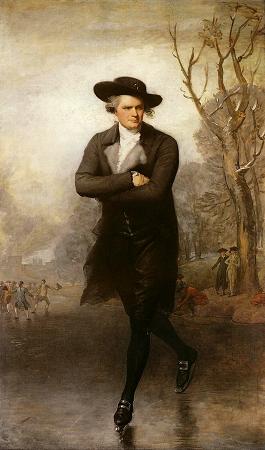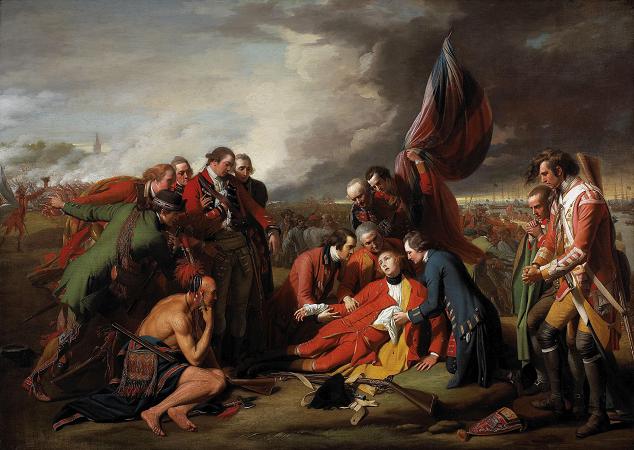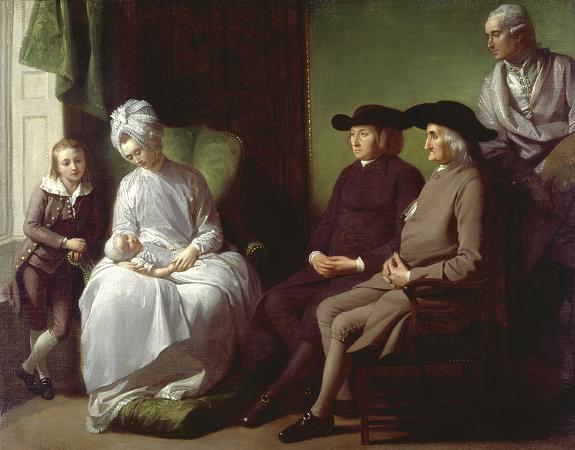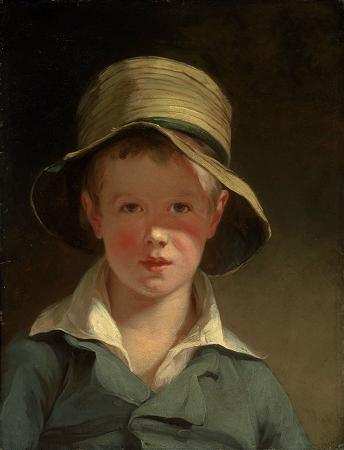Benjamin West (1738 - 1820). Benjamin West was a British North American artist, who painted famous historical scenes such as The Death of Nelson, The Death of General Wolfe, and Benjamin Franklin Drawing Electricity from the Sky. Entirely self-taught, West soon gained valuable patronage, and he toured Europe, eventually settling in London. He impressed King George III and was largely responsible for the launch of the Royal Academy, of which he became the second president. He was appointed historical painter to the court and Surveyor of the King's Pictures. West also painted religious subjects, as in his huge work The Preservation of St Paul after a Shipwreck at Malta, at the Chapel of St Peter and St Paul in Greenwich, and Christ Healing the Sick, presented to the National Gallery. West was born in Springfield, Pennsylvania, in a house that is now in the borough of Swarthmore on the campus of Swarthmore College, as the tenth child of an innkeeper and his wife. The family later moved to Newtown Square, Pennsylvania, where his father was the proprietor of the Square Tavern, still standing in that town. West told the novelist John Galt, with whom, late in his life, he collaborated on a memoir, The Life and Studies of Benjamin West that, when he was a child, Native Americans showed him how to make paint by mixing some clay from the river bank with bear grease in a pot. Benjamin West was an autodidact; while excelling at the arts, he had little education and, even when president of the Royal Academy, could scarcely spell. One day his mother left him alone with his little sister Sally. Benjamin discovered some bottles of ink and began to paint Sally's portrait. When his mother came home, she noticed the painting, picked it up and said, Why, it's Sally! and kissed him. Later, he noted, My mother's kiss made me a painter. From 1746 to 1759, West worked in Pennsylvania, mostly painting portraits. While West was in Lancaster in 1756, his patron, a gunsmith named William Henry, encouraged him to paint a Death of Socrates based on an engraving in Charles Rollin's Ancient History. His resulting composition, which significantly differs from the source, has been called the most ambitious and interesting painting produced in colonial America. Dr William Smith, then the provost of the College of Philadelphia, saw the painting in Henry's house and decided to become West's patron, offering him education and, more importantly, connections with wealthy and politically connected Pennsylvanians. During this time West met John Wollaston, a famous painter who had immigrated from London. West learned Wollaston's techniques for painting the shimmer of silk and satin, and also adopted some of his mannerisms, the most prominent of which was to give all his subjects large almond-shaped eyes, which clients thought very chic. West was a close friend of Benjamin Franklin, whose portrait he painted. Franklin was the godfather of West's second son, Benjamin. Sponsored by Smith and William Allen, then reputed to be the wealthiest man in Philadelphia, West traveled to Italy in 1760 in the company of the Scot William Patoun, a painter who later became an art collector. In common with many artists, architects, and lovers of the fine arts at that time he conducted a Grand Tour. West expanded his repertoire by copying works of Italian painters such as Titian and Raphael direct from the originals.In Rome he met a number of international neo-classical artists including German-born Anton Rafael Mengs, Scottish Gavin Hamilton, and Austrian Angelica Kauffman. In August 1763, West arrived in England, on what he initially intended as a visit on his way back to America. In fact, he never returned to America. He stayed for a month at Bath with William Allen, who was also in the country, and visited his half-brother Thomas West at Reading at the urging of his father. In London he was introduced to Richard Wilson and his student Joshua Reynolds. He moved into a house in Bedford Street, Covent Garden. The first picture he painted in England Angelica and Medora, along with a portrait of General Monckton, and his Cymon and Iphigenia, painted in Rome, were shown at the exhibition in Spring Gardens in 1764. In 1765 he married Elizabeth Shewell, an American to whom he became engaged in Philadelphia, at St Martin-in-the-Fields. Dr Markham, then Headmaster of Westminster School, introduced West to Samuel Johnson, Edmund Burke, Thomas Newton, Bishop of Bristol, James Johnson, Bishop of Worcester, and Robert Hay Drummond, Archbishop of York. All three prelates commissioned work from him. In 1766 West proposed a scheme to decorate St Paul's Cathedral with paintings.
more...














